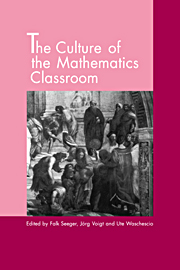Book contents
- Frontmatter
- Contents
- List of contributors
- Acknowledgments
- Introduction
- Part I Changing classroom culture
- 1 Joint activity in mathematics classrooms: A Vygotskian analysis
- 2 Evolution of classroom culture in mathematics, teacher education, and reflection on action
- 3 Reorganizing the motivational sphere of classroom culture: An activity-theoretical analysis of planning in a teacher team
- 4 The practice of teaching mathematics: Experimental conditions of change
- Part II Classroom processes
- Part III Epistemology and classroom culture
- Part IV Outlook
- Author index
- Subject index
1 - Joint activity in mathematics classrooms: A Vygotskian analysis
Published online by Cambridge University Press: 03 May 2010
- Frontmatter
- Contents
- List of contributors
- Acknowledgments
- Introduction
- Part I Changing classroom culture
- 1 Joint activity in mathematics classrooms: A Vygotskian analysis
- 2 Evolution of classroom culture in mathematics, teacher education, and reflection on action
- 3 Reorganizing the motivational sphere of classroom culture: An activity-theoretical analysis of planning in a teacher team
- 4 The practice of teaching mathematics: Experimental conditions of change
- Part II Classroom processes
- Part III Epistemology and classroom culture
- Part IV Outlook
- Author index
- Subject index
Summary
A dialogue: It is a very cold and clear February morning. The scene is in a 6th-grade classroom during a mathematics lesson.
Student: Teacher, why are the shadows cast by the sun not proportioned?
Teacher (surprised and perplexed): What? What do you mean?
Student: Oh, I was coming to school this morning. While I was walking, I looked at my shadow: The body was enormously long and the head so small.
(Garuti 1994, personal communication)What has the preceding dialogue got to do with school mathematics? Why does the student feel free to introduce an everyday problem, optimistic about the possibility of solving it in a school setting? Why does the teacher accept this dialogue? Does the student gain an answer to her request? What kind of answer?
The aim of this chapter is to answer these questions by analyzing the classroom culture that makes it possible to consider the dialogue as an emblematic representative of the standard classroom life.
The classroom in which this dialogue takes place is taught by a teacher–researcher (Rossella Garuti) who is involved in the Mathematical Discussion project; this project aims at designing, implementing, and analyzing long-term teaching experiments with a systematic recourse to classroom discussion orchestrated by the teacher. The theoretical framework of the project is mainly based on the seminal work of Vygotsky and his scholars and on the recent development of the cultural–historical school or activity theory (Bartolini Bussi 1996).
- Type
- Chapter
- Information
- The Culture of the Mathematics Classroom , pp. 13 - 49Publisher: Cambridge University PressPrint publication year: 1998
- 25
- Cited by



